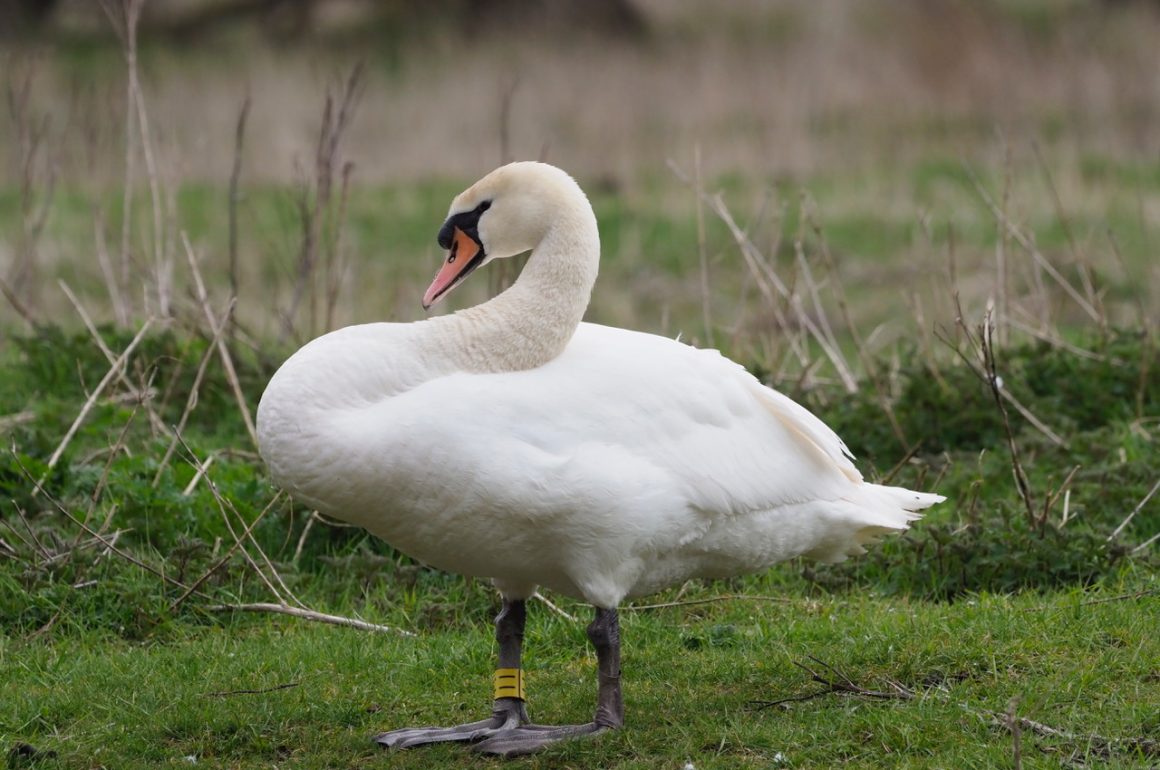
Most serious bird photographers dislike taking pictures of birds wearing rings (or what on the other side of the Atlantic you call bands). I can sympathise, as a shiny new ring, clamped to a bird’s leg, rarely enhances its portrait. Frustratingly, standard aluminium bird rings are almost always impossible to read unless the bird is in the hand, as even the best of photographs rarely allow the ring’s number to be read. I’d love to have known where and when the Great Spotted Woodpecker in my photograph below was ringed, but though the ring is clearly visible, the number stamped on it isn’t.
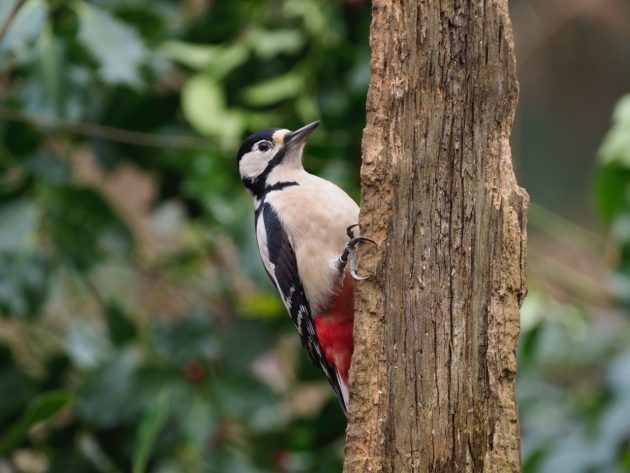
However, in recent years there’s been a growing trend to mark bigger birds, such as wildfowl and waders, with either colour rings, or Darvic plastic rings. The latter are always stamped with large letters or numbers, allowing them to be read easily with the help of a telescope or even binoculars. Then it’s a matter of doing a little research on the internet to find who rang the bird you saw, and then emailing the details of your sighting. With luck you will get a speedy reply, telling you the bird’s history.
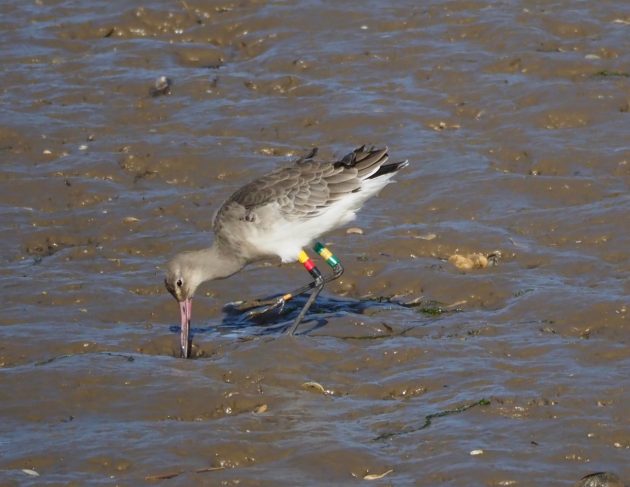
I photographed the Black-tailed Godwit in my photograph (above) on 18 September 2020. It was feeding on mud flats in the harbour of Brancaster Staithe, on the North Norfolk coast. With its striking combination of colour rings I suspected that it would be easy to find out more about this particular bird, and I was right. I discovered that it had been ringed on 26 September 2016 at Iken, on the River Alde on the Suffolk coast, so almost exactly four years before my sighting. The information I received didn’t indicate the age of the bird. Black-tailed godwits winter in large numbers on the estuaries of both Norfolk and Suffolk, and we know that nearly all these birds breed in Iceland. They are of the race islandica, a sub species of the nominate race, limosa. In breeding plumage islandica godwits develop a deeper red plumage than their limosa cousins. Very small numbers of limosa birds do nest in England, while a few islandica breed in Orkney and Shetland.
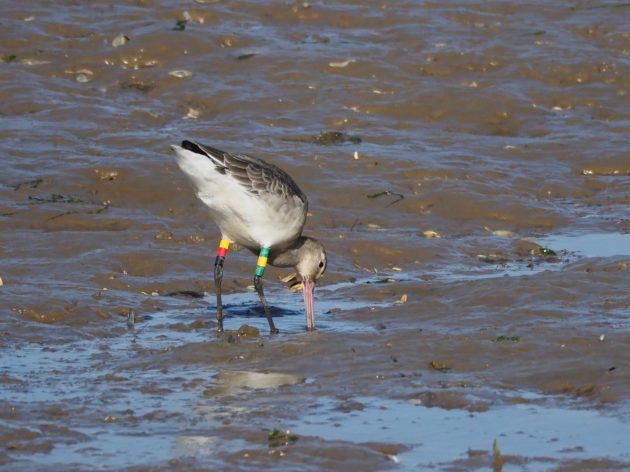
After being ringed my godwit (EY70 137) wasn’t seen again until 1 July 2017, when it was reported from Aldeburgh Town Marshes, not far from where it was first ringed. It then settled back at Hazlewood marshes on the Alde estuary; it was reported from here 12 more times until the last sighting on 9 September. Once again the bird disappeared, or at least wasn’t reported, until it was noted at Titchwell RSPB Reserve on the North Norfolk coast on 10 July 2018. It clearly liked Titchwell, for there were another 11 sightings from the same site, the last on 16 September. There was just one sighting away from Titchwell that summer, at Snettisham RSPB reserve, just a few miles west of Titchwell.
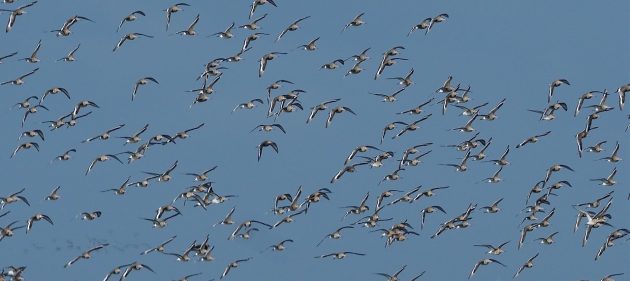
Black-tailed Godwits on the move. Most of the Icelandic population winters in the British isles
The sightings stopped, but then on 18 February 2019 EY70 137 was observed on Lady’s Island Lake, Wexford, Ireland. Was this where it spent its winters? It seems highly likely that it was. But it was back at Titchwell again on 6 July, before moving to nearby Brancaster Staithe on 13 August. There were seven more sightings of it here, the last on 20 October. Did it then move on to Ireland? In the summer of 2020 it was back at Brancaster Staithe again, with the first record on 23 July. It was reported several more times before my sighting, with the last record that I know of on 30 September. Black-tailed Godwits are long-lived birds, so EY70 137 may well be still be alive.
Such a terrific number of sightings of the same bird are impressive, and a reflection on the number of observers we have here in Norfolk and Suffolk. It was also notable that EY70 137 was a particularly confiding and approachable individual, which is why it was reported so many times. The repeat sightings reveal a great deal about the bird’s movements, but of course we don’t know where it bred. One assumes Iceland, but there’s no proof. That’s why the current trend to radio-tag birds reveals so much more than ringing, though it is of course vastly more expensive.
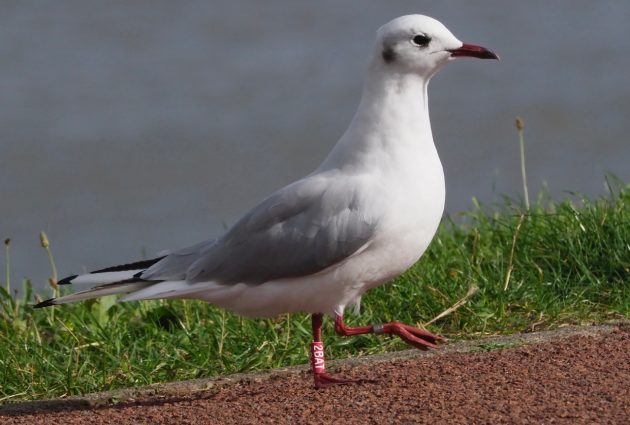
I photographed the godwit because of the rings, but when I pressed the shutter on the Black-headed Gull (above) I hadn’t even noticed that it was ringed. Only when I downloaded my images did I spot the ring, which was clear and easy to read (2BAT). Once again I did my internet research and managed to contact the person who had ringed the gull. I photographed it at Gorleston, on the Suffolk coast, on 5 September 2020, but I discovered that bird had been rung, as an adult, at nearby Great Yarmouth on 16 November 2013, so it was probably already nine years old, and could well have been older.
The first sighting of it after being rung was close to the town of Utena in north-east Lithuania on 11 July 2015. Though these gulls nest commonly in the British Isles, in the autumn great numbers move across to Britain from nesting grounds in Finland, Sweden and the Baltic states, so it seems most likely that 2BAT was a gull that had been bred in Lithuania, and that it returned to nest there every spring. It was, however, loyal to its wintering grounds in Suffolk, for it was seen again at Gorleston (where I photographed it) on 6 October 2016, 27 November 2016 and 14 November 2019. Whether it has been seen again I don’t know, but I found its history fascinating.
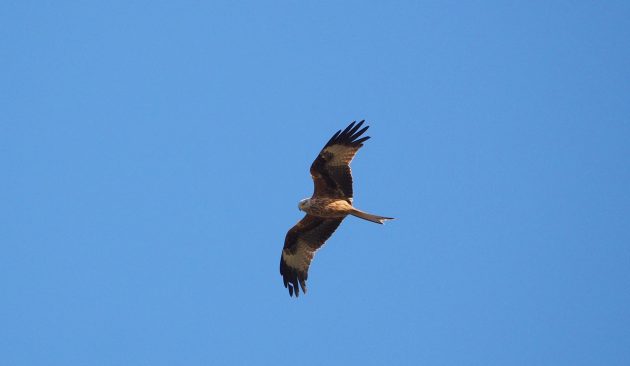
Rings are not the only way of marking birds, and with a number of species wing tags are more often used. When I photographed the Red Kite (above) near my home in Suffolk I hadn’t noticed its wing tags. It was only after I had downloaded my photographs on my iPad that I noticed that the bird was tagged, with a yellow tag 4F in each wing. A quick search on the Internet revealed that it had been tagged at Benington in North Hertfordshire in August 2018.
I sent my record to the Southern Colour Ringing Group, one of whose members had tagged and ringed the kite, and within an hour I had received a reply from the group’s leader, Paul Roper, telling me that this was the first sighting of one of the group’s tagged kites outside Hertfordshire, adding that “this was a bird caught in a spring trap in August so potentially a wandering bird that had been bred elsewhere. It was ringed by one of my trainees and he will be very pleased it has been seen such a distance away”. It was the first reported sighting of 4F since it was tagged 7 months and 27 days before, and it had travelled 82km NE.
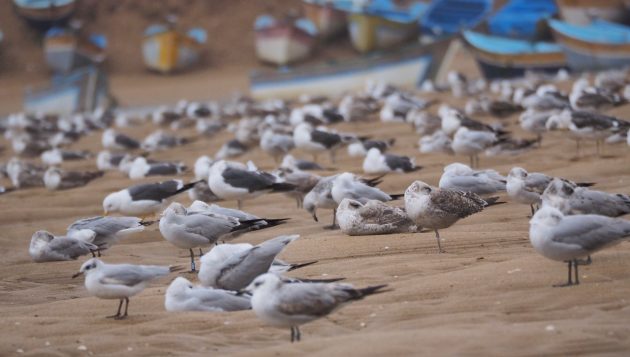
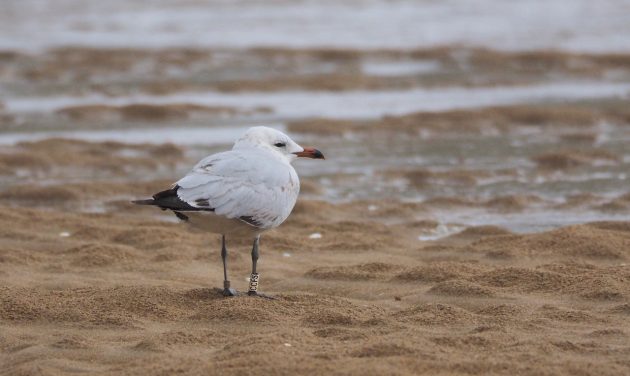
A week after seeing and photographing the kite I was in Northern Morocco, watching birds on the Merja Zerga, a sprawling estuary that it is an important feeding area for many migrant birds. Here I saw and photographed two Audouin’s Gulls, both carrying rings that I could read from my photographs (see photographs above). Audouin’s Gull is an attractive species restricted as a breeding bird to the Mediterranean, but many winter in North Africa. The rings revealed that one of the birds had been ringed as an adult in Portugal, the other as a chick in Spain’s Ebro delta, where the biggest colony of these gulls is to be found.
Tagging and marking birds with rings that can be read at a distance continues to reveal new facts about bird movements and migrations. It seems surprising that kite 4F hadn’t been recorded between being tagged in August and appearing in Suffolk in March, so one wonders where it had spent those months? In the case of the Audouin’s Gulls my sightings confirm the importance of the various wetlands and estuaries of North Morocco as wintering grounds. Because it has a relatively small population, Audouin’s Gull is classified as Vulnerable in the Spanish Red Book, which means it is at high risk.
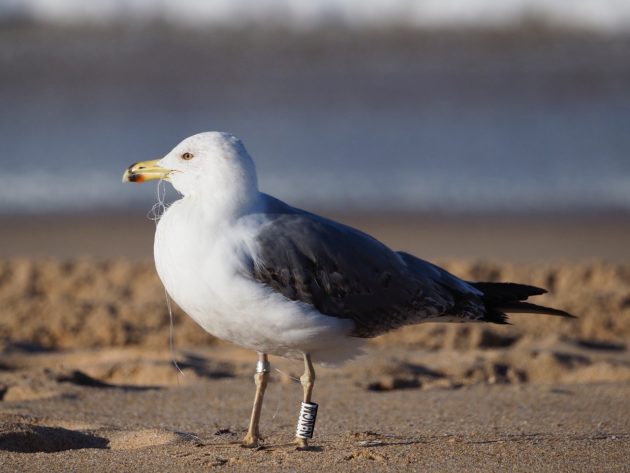
My most recent experience with a Darvic-ringed gull was in Andalucia last month, when I photographed the Lesser Black-backed Gull in my photograph (above) on the Playa de Zahora (Zahora beach, close to Cape Trafalgar). It was only when I first pointed my camera at it that I spotted the ring on its leg, while it wasn’t until I downloaded the photograph that I noticed that the unfortunate bird was badly entangled with nylon fishing line. As usual, I checked on its history, discovering that it had first been ringed at Marbella, near Malaga, on the Spanish Mediterranean coast on 5 October 2022. Sixteen days after being ringed it was seen at Rota, on Spain’s Atlantic coast, with the next sighting at Puerto de la caleta de Velez on 4 April 2023. There was one further sighting in 2023 at Vertedero R. S. U. los Ruices on 3 October. My photograph was taken on 4 February, 186km from the ringing site, and 584 days after it was first ringed. Through a few Lesser Black-backs nest in Spain, this bird was most likely to have been a winter visitor to the area from breeding grounds in Northern Europe. Jose Sanchez Cordero (the Luscinia banding group coordinator) kindly sent me this information, and he did ask me whether it was possible to catch the bird and untangle it. Sadly, it wasn’t, as the bird was still flying strongly. However, I doubt if it will be returning to Northern Europe this spring.


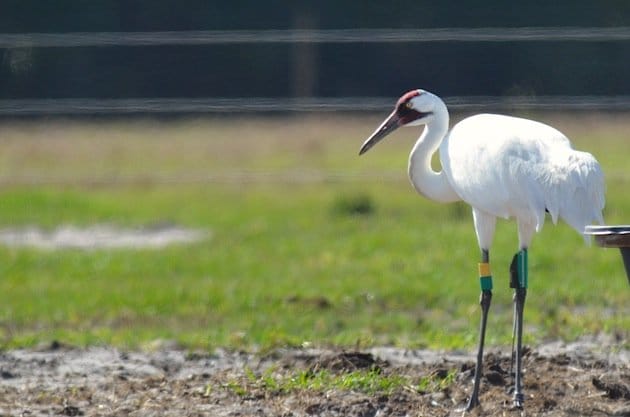
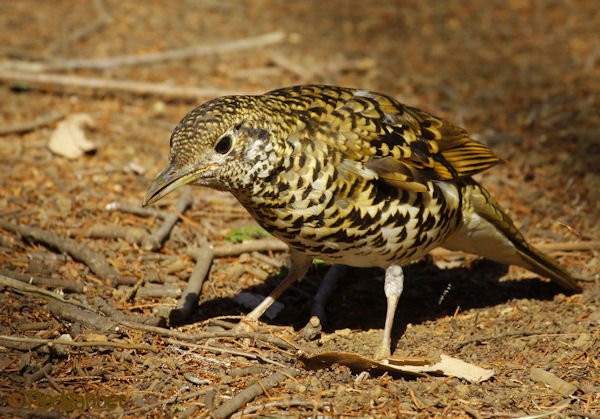
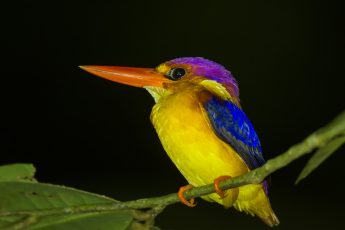

 New writers welcome – please contact us for details.
New writers welcome – please contact us for details.

















Leave a Comment